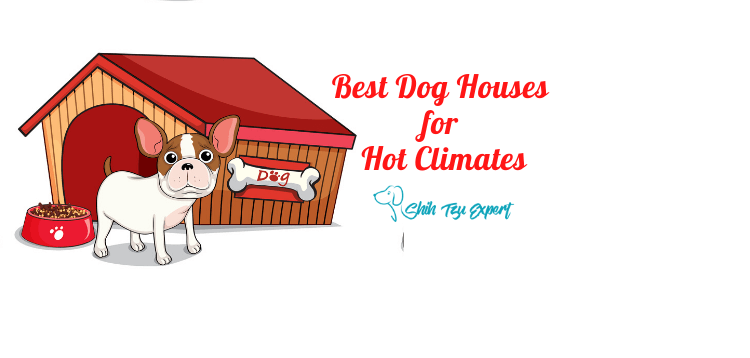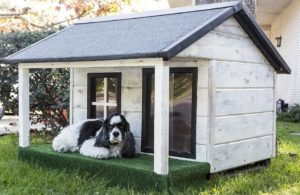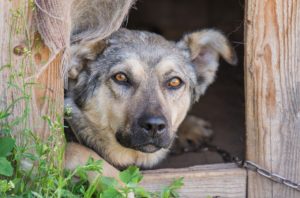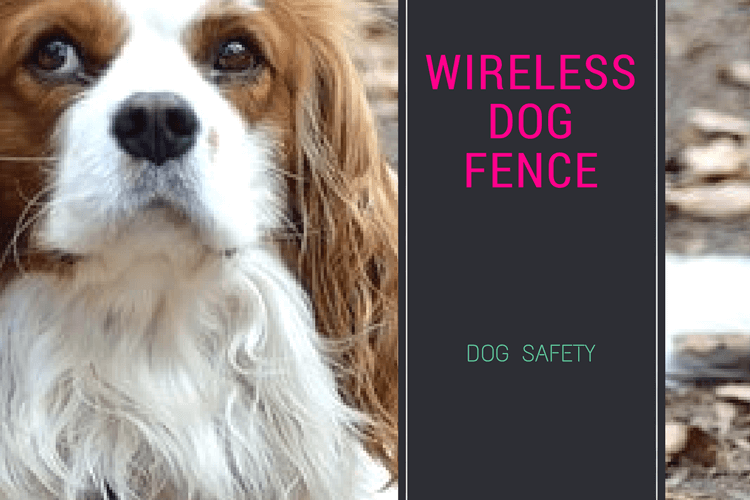 Summer is here, which means that dogs and dog owners alike want the best dog house for their fun summer activities! Every pup needs a nice place to cool off when they’re tired of playing fetch or running around during those long summer days. Of course, it’s important to remember that no dog house has the same ability to keep your dog cool and comfy as your air-conditioned home. Hot weather is just as dangerous for dogs as it is for us! We do not recommend you keep your dog outside in the backyard all day, as none of these dog houses has the technology to replace being indoors on a hot day!
Summer is here, which means that dogs and dog owners alike want the best dog house for their fun summer activities! Every pup needs a nice place to cool off when they’re tired of playing fetch or running around during those long summer days. Of course, it’s important to remember that no dog house has the same ability to keep your dog cool and comfy as your air-conditioned home. Hot weather is just as dangerous for dogs as it is for us! We do not recommend you keep your dog outside in the backyard all day, as none of these dog houses has the technology to replace being indoors on a hot day!
To keep your dog cool and make those outdoor days a little easier for them, we’ve curated a list of dog houses. We’ve also gone ahead and put together a list of essential things to remember when picking a dog house!

Best Dog Houses to Beat Scorching Hot Summers
Petsfit Outdoor Dog House
The patio feature and windows help create airflow throughout! The top of this dog house pulls up, and the floor is removable; these features make cleaning this dog house much more convenient. In addition to the easy cleaning, if placed in the proper location, pulling the roof up will help ensure a cooled off space for your pup, with more breeze! The weatherproofing done to this dog house also allows your pet to stay protected from the outside elements!
Pros:
- Lots of airflow
- Varying sizes from small dogs to big dogs
- Easy to clean
- Made with cedar, a natural flea and tick repellent
Cons
- Not insulated, may not keep a dog warm in winter.
- Not pre-built
- Some customers noted having to weatherproof the wood further.
Suncast Outdoor Dog House
Are you worried about your dog house matching your outdoor decor? Look no further! The Suncast Outdoor Dog House matches all types of outdoor decor and keeps your dog cool at the same time! The materials this dog house is made from resist color fading while also being easy to wash, and can hold up to 70 pounds!
Pros:
- Snaps together
- Easy to wash
- Durable
Cons:
- No extra windows for ventilation
- A few customers noted the dog house snapping apart after assembly. Always return defective products.
Petmate Indigo Microban Igloo
Additionally, the Petmate Indigo Microban Igloo has a vent in the roof to promote more airflow. Petmate also offers doors and pads for their Igloo for added comfort! These items are available for purchase separately!
Pros:
- Off-set door-way for protection from elements
- Vent in roof for more airflow
- Microban helps fight stains and odors
Cons:
- Only comes in three sizes (Medium, Large, and Extra Large)
- May not be suitable for smaller dogs.
Petmate Precision Extreme Outback Log Cabin
This dog house comes in 4 different sizes, ranging from small to extra large, and is easy to assemble! If a curated look for your backyard is essential for you, the Petmate Precision Extreme Outback Log Cabin has a sleek and modern design that can tie a yard together.
Pros:
- Asphalt, slanted roofing
- Wood and stainless-steel hardware exterior
- Adjustable feet
- Four sizes (Small to Extra Large)
Cons:
- Some customers have experienced damaged parts upon delivery. Always send back defective products.
Petmate Precision Pet Log Cabin
The Petmate Precision Pet Log Cabin has a slanted roof for rain resistance. It also comes in three sizes, ranging from small to large, and promises to be weather, pest, rot, and rust-resistant!
Pros:
- Raised flooring
- Easy to assemble
- Slanted roof for rain resistance
Cons:
- No additional windows for extra air to get in
- May not be suitable for extra-large dog breeds due to limited sizes.
Why is Hot Weather Dangerous?
Like humans, if a dog is left outside too long without water or a cool place to hide from the burning summer sun, they can suffer heat exhaustion or heatstroke. Both can result in long term effects on pet health. In dogs, signs of heatstroke and heat exhaustion can be anything from a raised temperature, rapid breathing, and glazed eyes to excessive salivation and staggering when walking. Take care to notice these behaviors, and if you should see your dog exhibiting any, immediately move them to a colder area and take them to the vet!
In addition to heatstroke and heat exhaustion, overtly hot sidewalks can be harmful to your pet. An overly-hot paved path can cause blisters on your dogs paw-pads. It’s crucial to touch the pavement with your bare hand to check how warm it is before going on a walk. If the pavement is hot to touch, or feels uncomfortable on your hands, it is too hot to take your dog on a walk! Since dogs don’t sweat as well as humans do, they have a harder time cooling down in warm climates.
It’s also important to note that your dog’s average temperature is higher than humans. A healthy dog can regularly sit around 101.5 degrees Fahrenheit or 38.6 degrees Celsius, and while that may seem high to us, it’s natural for our pets!
How Do Dogs Regulate Their Body Temperature?
Dogs do sweat, but only from their paw pads. The reason for this is that dogs can only sweat in places where fur does not cover their skin! As you can probably imagine, the sweat from their paw pads doesn’t do much to cool them down. That is why dogs pant! Panting allows dogs to evaporate the moisture from their nasal passages, tongue and the lining of their lungs. The air that’s produced through your dog panting cools them down!
Dogs also regulate their body temperature through sweat glands. While not all the sweat glands dogs have work the way ours do—because of their fur—they do have sweat glands all over their body! Dogs have two kinds of sweat glands: Merocrine Glands and Apocrine Glands.
Merocrine Glands are in your dog’s paw pads, and they ensure your dog’s sweat evaporates appropriately. These sweat glands function closest to the way that humans sweat glands do. When your dog’s internal temperature rises, these glands activate! On hot days, you might notice wet paw prints where your dog has walked; this is because they’re sweating from their paw pads. When you see these damp paw prints, make sure you get your dog into a space with water and cold air!
Apocrine Glands work differently. While these glands are located all over your dog’s body, the release pheromones and not sweat. They in no way help cool your dog’s body down.

How to Cool a Dog House in the Summer
Any pet parent wants to make sure that their dog house is safe and cool enough for their pup on those scorching summer days! While there are many things to consider, like size and durability, you should also take time to consider materials, location, insulation, cooling beds, and more. We’ve gone ahead and curated features to remember when trying to cool your dog house down!
Size
It might seem obvious, but your dog should have enough space to turn around and lay comfortably in their dog house. Consider this, too: When your animal is hot, they will want to stretch out when they lay down to help cool them off. You’ll want them to have space to hide from the sun and stretch out comfortably! Another critical reason to consider size is airflow and ventilation. When your dog has a big enough area to move around and stretch-out without issue, they will also have better airflow as well as a better environment!
The size of your dog house will matter just as much as the other aspects of a dog house we discuss in this article. Sizing is poignant because proper ventilation is nearly impossible without ensuring appropriate sizing for your specific dog. If you’ve got a puppy, you should remember to build or buy your dog house with your puppy’s breed in mind. For example, Doberman puppies will grow to be 26 to 28 inches tall and weigh 60 to 80 pounds! A small dog house will not work for your large breed dogs after a few months; be ahead of the game, and buy or build a larger dog house!
Choose the Right Material
Wood: Wood is generally believed to be the best material for dog houses! When choosing a wood, it is recommended you use cedar or redwood. These woods are both strong, durable, and more breathable. If well insulated and vented, your dog can be much cooler in a wooden dog house than a plastic one. Wooden dog houses also tend to have extra windows for added ventilation, as opposed to plastic ones. Plastic and metal dog houses can absorb the heat and the cold, and therefore aren’t as well suited for maintaining an ideal temperature in your dog house.
While wood is the best material, it does have its downsides. If you have a sunny backyard with less tree coverage, you might want to consider this point: Wooden dog houses are much heavier and can be harder to move than a plastic dog house. To add to this, there are also issues with termites in wooden dog houses. Though termites are not inherently dangerous to dogs or humans by biting them, an infestation of termites can ruin your dogs home!
Additionally, it’s essential to know if your dog is allergic to any type of wood. Some dogs may have allergies to cedar, a wood used to make many dog houses. Regardless of allergies, remember that you should only use woods that are not color-treated or have been treated with non-toxic chemicals (paints and stains). Wooden dog houses will also need to be weather-treated from time to time to withstand the changing climates. When weather-treating your dog house, remember to ensure that the chemicals used are non-toxic and safe for pets!
Plastic: Many dog houses, including some listed above, are made from a very sturdy, and lightweight plastic. They’re also waterproof without needing any additional waterproofing, as wooden dog houses do! Plastic dog houses are also often easier to assemble, as they have pieces that lock in together, instead of nails or screws for assembly! Additionally, as mentioned earlier, plastic dog houses make moving your dog house or rearranging your backyard much easier. If you know that a certain part of your yard receives more sunlight at a particular point in the day, you might want to be able to quickly move your dog house to help keep your dog cooler!
You might also consider a plastic dog house because they make cleaning up after your pet more straightforward, which also makes it easier to eliminate odors that may surface! Some plastic dog houses come with microban built-in, which also helps eliminate odors and stains!
One of the more significant downsides to plastic dog houses is that they tend not to be raised off the ground. On top of this, plastic is a less breathable material, and therefore may be warmer if not adequately ventilated! In addition to this point, wooden dog houses tend to have extra windows and door openings without a covering. These are all critical things to consider when deciding on the best material for your dog’s house!
Location is Everything
Also, take time to consider that if you place your dog house in an area of your yard where there tends to be a lot of standing water after a rainfall, you will have issues with wooden or concrete-floored dog houses. We recommend taking a walk around your backyard—after rain, and before deciding on placement—and see where the best water run-off is. If there’s no suitable place in your yard because of standing water, place a raised dog house. Ensure that you pick a spot for your dog’s house with good shade, proper run-off, and indirect sunlight. These are best for your pups home!
Use Ice and Water
It’s also a great idea to always have ice and water near your dog’s house! Water helps regulate body temperature, and cooling it with ice can make it refreshing and delicious!
Add Some Insulation
Do keep in mind when using fiberglass insulation that your pet should not be able to come into contact with the fiberglass at any point, as it can be very harmful for them!
Dog House Insulation Kits
We recommend dog house insulation kits because these kits are made of a breathable cloth! The cloth insulation is excellent because it’s machine washable, making it easy to clean if your dog is muddy or dirty when they lay on it! Additionally, insulation kits help keep the actual wood or plastic interior of your dog house clean, since there is a layer of fabric between your pup and their dog house. Insulation kits can also keep your dog comfortable in warm and cold weather, and double as a soft layer for your dogs to lay on if you’d like to avoid adding a bed in their dog house!
The cons of insulation kits are that they aren’t available for all kinds of dog houses, and they could get messed up and need to be replaced! Though they may be the comfiest and safest route for you, it’s important to keep this in mind!
Removable Dog House Doors
Consider what kind of doors, if any, are on the dog houses you’re looking into. When the weather gets hot, take the door(s) off of your dog house. Removable doors help the air in your dog’s home flow better, keeping your dog cooler!
Remember always to ensure that your dog house is neither in direct sunlight or facing it, especially if removing doors that help block sunlight.
Dog Houses That Are Raised Off the Ground
Keeping a dog house raised off the ground also aids airflow. Later in this article, we will discuss raised beds as well. Raising your dog’s body off the floor allows air to flow all around their bodies, keeping them colder, more comfortable, and helps avoid overheating or heat exhaustion!
Cooling Beds
It should be noted that the cooling bed should be taken from the dog’s house immediately if any damage is found. While the gel beds are often made with non-toxic materials, there have been cases of loose stool and upset stomachs in dogs who have ingested the gel.

Raised Bed
Is your dog not comfortable walking onto a water or gel bed? Consider a raised bed for their dog house! Aside from raised beds promoting airflow on all sides of your dog, they’re chew-resistant, can help your dog dry off faster, and are easy to clean! While there are many pros to a raised dog bed, it’s important to note that they can be a bit big for a dog house.
Circulation Fans
Another great option is using a fan in their dog house! Fans are great to help encourage more airflow! If your pet has a smaller space, the fan will benefit them greatly, keeping a consistent breeze in their space!
Having a circulation fan in a dog house could be tricky, as there may be cords involved. If you choose to use a fan, remember always to take your fan back inside after your day to ensure nothing happens to the fan, cord, or dog house should the weather take a turn!
Exhaust Fans
If you like the idea of a fan, but aren’t sure how you feel about a circulation fan, consider investing in an exhaust fan! Exhaust fans are built-in to a dog house and can get their power via solar panel. The solar panels eliminate the issues that circulation fans have, while also being eco-friendly!
Need another source of power on cloudy days? Exhaust fans do come with additional power cords you can use to plug the fan into an outlet! Another welcome addition to the exhaust fan is their easy to close vents for cooler weather!
Air Conditioning Units
If the dog house is big enough, or if your dogs will be outside for an extended period, you might consider getting a small air conditioning unit for your pups! While this may seem like a big step, air conditioning units will keep your dog cooler than exhaust or circulation fans can.
Additionally, there are such things as air conditioning units that double as heaters for dog houses. Therefore, this investment can be an asset to your dog and their comfortability all year long! These units are relatively easy to install, but it is crucial that you still insulate the dog house when using these units to help keep the air or heat in the dog house, and better aid your pup.




![6 Best Dog Treadmills for 2023 [Buyer’s Guide] 6 Best Dog Treadmills for 2023 [Buyer’s Guide]](https://shihtzuexpert.com/wp-content/uploads/2019/04/Best-Dog-Treadmills-1.png)
![10 Best Dog Crates for Separation Anxiety [High anxiety dog crates 2019 Reviews] 10 Best Dog Crates for Separation Anxiety [High anxiety dog crates 2019 Reviews]](https://shihtzuexpert.com/wp-content/uploads/2019/05/5-3.jpg)


